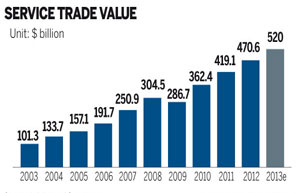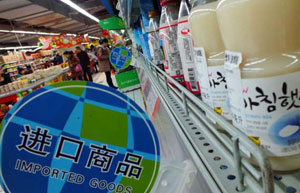Take trade to higher level
By Zhang Monan (China Daily) Updated: 2014-02-18 07:49With its traditional development dividends shrinking, China must develop its knowledge-intensive services to compete
China's $4.16 trillion import and export volume in 2013 means it is sure to replace the United States as the world's largest goods trader. However, it still lags far behind the US in the trade in services. Given that the focus of global economic competition has now shifted from the trade in goods to the trade in services, China should regard boosting its trade in services as an important way of raising its capability of participating in international competition and promoting the transformation of its trade from quantity to quality.
China's services trade continued its previous growth momentum and reached a record high in 2013, with the value of imports and exports of services reaching $484.7 billion in the first 11 months of the year, an increase of 12.4 percent on the same period the previous year, data from the Ministry of Commerce show. The full-year value is expected to exceed $520 billion, a growth rate of more than 11 percent year-on-year. But compared with developed countries, this volume is not only small in size it is also low in quality and there is still an enormous space for improvement in the future.
China's status in international trade has been on the rise and its services trade has also achieved considerable progress in recent years, with its proportion in the world's total increasing from 0.6 percent in 1982 to 5.6 percent in 2012. However, compared with some developed countries, China's services trade is still seriously imbalanced. For example, the services exports of the US, the United Kingdom, Germany, France and Italy are more than 10 percent of their gross national product.
In comparison, China's services trade has suffered a deficit for 12 consecutive years. This reflects the obvious gap with developed economies in terms of its services trade competitiveness and is partly caused by its increased services imports in the context of its further opening-up since its accession to the World Trade Organization.
Currently, the international services trade tends to be knowledge, technology and capital-oriented and services trading sectors have gradually transformed from the traditional natural resources or labor-intensive into knowledge and technology-intensive industries, a kind of structural optimization of the services trade. However, China is still weak in terms of trade in capital-intensive and knowledge-intensive services and its comprehensive competitiveness in this area is yet to be raised.
The country's high value-added services trade, such as in insurance and financial services, has grown rapidly in recent years, but they still hold a relatively low share in its total imports and exports of services. In 2010, about half of the country's services trade was concentrated in the transportation, tourism and other traditional areas, compared with only 7.6 percent in such high value-added services as finance, insurance, and information and telecommunication services.
|
 |
 |
- NHTSA says finds no 'defect trend' in Tesla Model S sedans
- WTO rare earth ruling is unfair
- Amway says 2014 China sales may grow 8%
- President Xi in Europe: Forging deals, boosting business
- CNOOC releases 2013 sustainability report
- Local production by Chery Jaguar Land Rover this year
- Car lovers test their need for speed in BMW Mission 3
- China stocks close mixed Monday

















